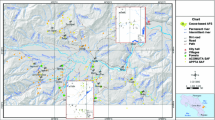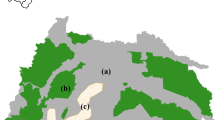Abstract
The role of different agroforestry systems in the conservation of plant diversity and forest structure has not been directly compared in many agricultural dominated landscapes. In this study, we investigated tree diversity and forest structure in a complex agroforestry landscape traditionally grown for cocoa and mixed food crops and compared these to the natural forest in southeastern Ghana. The study was carried out using 36 25 m × 25 m plots. There was significant difference [95% Confidence Interval (95% CI)] in the native forest/non-crop tree species richness between the natural forest and the agroforest farmlands but species richness was similar between the cocoa and mixed food crops agroforests. The density of native forest/non-crop trees was significantly higher (P < 0.05) in the natural forest but similar between cocoa and mixed food crops agroforest. Similarly, the basal area of native forest/non-crop trees was significantly higher (P < 0.05) in the natural forest but comparable between cocoa and food crops agroforest. Of the 20 most abundant native forest/non-crop trees recorded, 12 of them showed significant responses (P < 0.05) to land use change with nine of the species significantly abundant in the natural forest relative to the agroforest systems. Eighteen native forest/non-crop trees species in the agroforestry systems were commonly recorded as being used; 100% of them being used as fuel wood with 83.3 and 77.8%, respectively, used as medicines and materials. The findings of this study suggests that although complex agroforestry systems are a poor substitute for the natural forest the heterogeneous mosaic landscape in which complex agroforestry forms part can be strategically managed to maximize the benefits of both sustainable agriculture production and conservation of plant diversity by acting as buffer between protected areas and intensively managed areas.




Similar content being viewed by others
References
Asase A, Ofori-Frimpong K, Ekpe PK (2009) Impact of cocoa farming on vegetation in an agricultural landscape in Ghana. J Afr Ecol 48:338–346
Attua EM (2003) Land cover change impacts on the abundance and composition of flora in the Densu basin. West Afr J Appl Ecol 4:27–33
Bisseleua D, Hervé B, Vidal S (2007) Plant biodiversity and vegetation structure in traditional cocoa forest gardens in southern Cameroon under different management. Biodivers Conserv 17:1821–1835
Bobo K, Waltert M, Sainge NM, Njokagbo N, Fermon H, Mühlenberg M (2006) From forest to farmland: species richness patterns of trees and understorey plants along a gradient of forest conversion in southwestern Cameroon. Biodivers Conserv 15(13):4097–4117
Bruner AG, Gullison RE, Rice RE (2001) Effectiveness of parks in protecting tropical biodiversity. Science 291:125–128
Chao A, Chazdon RL, Colwell RK, Shen T-J (2005) A new statistical approach for assessing similarity of species with incidence and abundance data. Ecol Lett 8:148–159
Colwell RK (2006) EstimateS: statistical estimation of species richness and shared species from samples, version 8. Persistent URL http://purl.oclc.org/estimates
Coomes Ot, Grimard F, Burt GJ (2000) Tropical forests and shifting cultivation: secondary forest dynamics among traditional farmers of the Peruvian Amazon. Ecol Econ 32:109–124
Crawley MJ (2007) The R book. Wiley, New York, 942 pp
Duguma B, Gockowski J, Bakala J (2001) Smallholder cacao (Theobroma cacao) cultivation in agroforestry systems of west and central Africa. Challenges and opportunities. Agrofor Syst 51:177–188
FAO (2003) Socio-economic analysis and the roles of agriculture in developing countries: County Case Study: Ghana. FAO, Roles of Agriculture Project, Rome and Institute of Statistical, Social and Economic Research, University of Ghana, Legon
Fitzherbert EB, Struebig MJ, Morel A, Danielsen F, Brühl CA, Donald PF, Phalan B (2008) How will oil palm expansion affect biodiversity? Trends Ecol Evol 23(10):538–545
Forestry Commission (2003) Biodiversity management plan for the Atewa Range Forest Reserves for the period 2003–2008. Forestry Commission
Gajaseni J, Matta-Machado R, Jordan CF (1996) Diversified agroforestry systems: butters for biodiversity reserves, and land bridges for fragmented habitats in the tropics. In: Szaro RC, Johnson DW (eds) Biodiversity in managed landscapes; theory and practice. Oxford University Press, Oxford, pp 506–513
Gascon G, Williamson GB, Da Fonseca GAB (2000) Receding forest edges and vanishing reserves. Science 288:1356–1358
Gotelli NJ, Colwell RK (2001) Quantifying biodiversity: procedures and pitfalls in the measurement and comparison of species richness. Ecol Lett 4:379–391
Guiracocha G, Harvey CA, Somarriba E, Kraus U, Carillo E (2001) Conservatión de la biodiversidad en sistemas agroforestales con cacao y banana en Talamanca, Costa Rica. Agoforestería en las Américas 8:7–11
Hall JB, Swaine MD (1981) Distribution and ecology of vascular plants in tropical rainforest: forest vegetation in Ghana. W. Junk, The Hague
Hawthorne WD (1990) Field guide to the forest trees of Ghana. Natural Resources Institute, Chatham, 278 pp
Hawthorne W, Abu-Juam M (1995) Forest protection in Ghana: with particular reference to vegetation and plant species. IUCN, Switzerland, 203 pp
Herve BD, Vidal S (2008) Plant biodiversity and vegetation structure in traditional cocoa forest gardens in southern Cameron under different management. Biodivers Conserv 17:1821–1835
Kammesheidt L (2002) Perspectives on secondary forest management in tropical humid lowland America. Ambio 31:243–250
Legendre P, Legendre L (1998) Numerical ecology: developments in environmental modelling, vol 20, 2nd edn. Elsevier Science, Amsterdam
Makana J, Thomas SC (2006) Impacts of selective logging and agriculture clearing on forest structure, floristic composition and diversity, and timber tree regeneration in the Ituri Forest, Democratic Republic of Congo. Biodivers Conserv 15:1375–1397
Myers NRA, Mittermeier CG, Mittermeier GAB, Fonseca Da, Kent J (2000) Biodiversity hotspots for conservation priorities. Nature 403:853–858
Oke DO, Odebiyi KA (2007) Traditional cocoa-based agroforestry and forest species conservation in Ondo State, Nigeria. Agric Ecosyst Environ 122:305–311
Perfecto I, Rice RA, Greenberg R, Van Der Voort ME (1996) Shade coffee: a disappearing refuge for biodiversity. Bioscience 46:598–608
Rice RA, Greenberg R (2000) Cacao cultivation and the conservation of biological diversity. Royal Swedish Academy of Sciences. Ambio 29(3):167–173
Saatchi S, Agosti D, Alger K, Delabie J, Musinski J (2001) Examining fragmentation and loss of primary forest in southern Bahian Atlantic forest of Brazil with radar imagery. Conserv Biol 15:667–875
Schroth G, Harvey CA (2007) Biodiversity conservation in cocoa production landscapes: an overview. Biodivers Conserv 16:2237–2244
Schroth G, Dan Foneseca AB, Harvey CA, Gascon C, Vasconcelos HL, Izac A-MN (eds) (2004) Agroforestry and biodiversity conservation in tropical landscapes. Island Press, Washington, DC
Van Dijk J-M (1999) Non-timber forest products in the Bipindi-Akom Region, Cameroon. A socio-economic and ecological assessment. The Tropenbos-Cameroon Programme, Kribi
Van Gemerden BS, Olff H, Parren MPE, Bongres F (2003) The pristine rain forest? Remnants of historical human impacts on current tree species composition and diversity. J Biogeogr 30(9):1381–1390
Verissimo A, Bareto P, Tarifa R, Uhl C (1995) Extraction of a high-value resource in Amazonia: the case of mahogany. For Ecol Manag 72:39–60
Witte J (1992) Deforestation in Zaire: logging and landlessness. Ecologist 22:58–65
Zapfack L, Engwald S, Sonké B, Achoundong G, Madong BA (2002) The impact of land use conversion on plant biodiversity in the forest zone of Cameroon. Biodivers Conserv 11:2047–2061
Acknowledgements
We are most grateful to the people of Adjeikrom for their hospitality during fieldwork. Thanks also to Earthwatch Institute (Europe) and Nature Conservation Research Centre (NCRC) for partial funding of the fieldwork. We are thankful to Mr. J. Y. Amponsah at the Department of Botany for assistance with tree identification.
Author information
Authors and Affiliations
Corresponding author
Appendix 1
Appendix 1
Rights and permissions
About this article
Cite this article
Asase, A., Tetteh, D.A. The role of complex agroforestry systems in the conservation of forest tree diversity and structure in southeastern Ghana. Agroforest Syst 79, 355–368 (2010). https://doi.org/10.1007/s10457-010-9311-1
Received:
Accepted:
Published:
Issue Date:
DOI: https://doi.org/10.1007/s10457-010-9311-1




